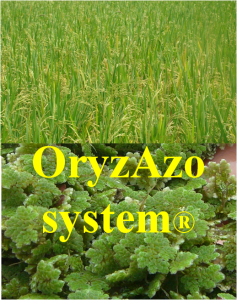 A description by Jonathan and Alexandra Bujak of the Arctic Azolla Event, and how azolla could help us today. Click here Bujak Geoscientist June 2014 to download a pdf of the article. Geoscientist is the monthly magazine of the Geological Society of London, the oldest geological society in the world, founded in 1807. You can also view the June 2014 issue of Geoscientist here.
A description by Jonathan and Alexandra Bujak of the Arctic Azolla Event, and how azolla could help us today. Click here Bujak Geoscientist June 2014 to download a pdf of the article. Geoscientist is the monthly magazine of the Geological Society of London, the oldest geological society in the world, founded in 1807. You can also view the June 2014 issue of Geoscientist here.
‘Nitrogen-Azolla-rice. A New Global Paradigm.’
An illustrative article by Dr Mariano Montaño Armijos showing his ‘AryzAzo‘ System for natural biofertilization of rice in Ecuador.
This natural eco-friendly system is compared with the dangers of urea-based chemical fertilizers.
Dr Armijos is an Azolla Foundation Associate who lives in Ecuador.
‘The Wonder Fern Azolla’
 India’s Natural Resources Development Project (VKNARDEP) published ‘The wonder fern Azolla‘ in English which is available for purchase from their website http://vknardep.org/publications/english-books/187-the-wonder-fern-azolla.html.
India’s Natural Resources Development Project (VKNARDEP) published ‘The wonder fern Azolla‘ in English which is available for purchase from their website http://vknardep.org/publications/english-books/187-the-wonder-fern-azolla.html.
The book has fourteen chapters and provides detailed concepts and methodology of NARDEP’s mode of azolla cultivation. It also includes the diagrams of various methods of integration of this technology with the farmer’s homestead and agronomical practices to be followed in using azolla in the paddy field.
The award-winning methodology outlined in this book was developed by Dr Kamalasanan Pillai at NARDEP. You can view a short video of his method on our website page.
‘The Azolla Cooking and Cultivation Project’ by Erik Sjödin
‘The Azolla Cooking and Cultivation Project’ was published in 2012 by Erik Sjödin.
The book contains details about Azolla‘s cultivation, plus several recipes developed by him that use azolla as the main ingredient. These include azolla soup, azolla burgers, azolla pancakes, Azolla hardtack, and azolla bread.
The book is available from Erik Sjödin as a pdf, as a paperback at Amazon US / UK, and as an e-book at Kindle Store.
‘The Power of Duck‘ by Takao Furuno
 A description of Takao Furuno’s integrated method of sustainable rice-duck-azolla-fish farming in Japan.
A description of Takao Furuno’s integrated method of sustainable rice-duck-azolla-fish farming in Japan.
Details (paraphrased from the Amazon website description):
“If you are like us, on a quest for knowledge about sustainable design systems… HAD ENOUGH? We’re talking about the rubbish popularised by chemical companies that rice production is chemically dependent – 10,000 Japanese rice growers have proved otherwise. This book is written by a farmer for farmers – a complete guide to integrated duck and rice farming. Takao Furuno, a Japanese rice farmer has been producing sustainable, profitable organic rice for the last ten years.
Abundantly illustrated, tabled and photographed, this book serves as a text-book for case studies and farmer-evolved natural systems.”
‘Azolla Biofertilizer for Sustainable Rice Production’
 Details (paraphrased from the Amazon website description):
Details (paraphrased from the Amazon website description):
“This book contains the valuable information from the vast experiences of the authors Professor Dr S. Kannaiyan and Dr K. Kumar in the field of azolla–anabaenasymbiosis for the past 25 years.
It is written with the objective of providing basic knowledge and practical technologies on the effective utilization of azolla as an ecofriendly and economically viable biofertilizer for sustainable rice production. It gives an access to the latest information on the biology of azolla, growth, sporulation, N2 fixation, ammonia assimilation and mineralization process in rice ecosystem.
The book offers a good deal of practical technologies for maximum exploitation of the potential status of azolla biofertilizer viz., mass production techniques of fresh biomass, sporocarp inoculum, carrier based immobilized cyanobacterial inoculant, field application and methods for enhancing N2 use efficiency of this technology.
The book also covers the utility of azolla as supplemental animal feed and the economics of usage of azolla as biofertilizer for rice. Illustrative colour photographs have been included in various chapters for easy understanding of the subject by readers.
This book will be very useful for the scientists, researchers, postgraduate students, extension workers and voluntary organizations involved in the crop management technology for sustainable rice production.”
The book is available from the Amazon bookstore as a Kindle e-book and as a hardcopy book.
Eco-friendly Coffee by Dr Anand & Geeta Pereira
 This beautifully written and illustrated book is written by husband and wife team Dr Anand & Geeta Pereira, who own a coffee farm, ‘Joe’s Sustainable Farm’, in Sakleshpur Taluk on the foothills of Western Ghats of India – a UNESCO World Heritage Site and one of the eight “hottest hotspots” of biological diversity in the world.
This beautifully written and illustrated book is written by husband and wife team Dr Anand & Geeta Pereira, who own a coffee farm, ‘Joe’s Sustainable Farm’, in Sakleshpur Taluk on the foothills of Western Ghats of India – a UNESCO World Heritage Site and one of the eight “hottest hotspots” of biological diversity in the world.
The farm has become a model for both Indian and foreign farmers, and many visit the farm to seek technical help in setting up coffee estates. The authors are also regular contributors to ineedcoffee.com and give lectures on the intrinsic value of shade-grown coffee. They are Board of Studies Members in St. Aloysius College and St. Agnes College, Mangalore, Karnataka State.
Anand and Geeta have worked diligently on sustainable technologies for the past 25 years to develop a practical and sustainable system that can greatly benefit other coffee farmers. This includes rainwater harvesting techniques using their ‘Rain gun sprinkler system’, and the integration of multiple complementary crops including coffee, areca nut, pepper, banana, ginger, orange and rice.
The book has three aims:
- To help coffee farmers grow economically sound and ecologically safe coffee by providing them with a working knowledge of horticulture, microbiology and allied sciences.
- To help connoisseurs of coffee worldwide appreciate the significance of shade-grown coffee and its positive impact on ecology.
- To organize the subject so that it reflects modern science, both in the laboratory and in the field, for students from various scientific disciplines.
The book’s forty chapters are grouped into several sections: Overview, Water, Ecology, Microbiology, Nutrient Dynamics, Physiology and Miscellaneous which includes a discussion of the possible impact of climate change.
Dr Anand & Geeta Pereira are Azolla Foundation Associates and the full title of their book is ‘Shade Grown Eco Friendly Coffee – Volume 1 (2009)’.
“Biofertilizer Germplasm Collections at IRRI” by Watanabe, I., Roger, P.A., Ladha, J.K. & Van Hove, C. 1992. Publication of the International Rice Research Institute.
 “The description of the biofertilizer germplasm maintained at IRRI is intended to accelerate its use and exchange among researchers all over the world. We hope it catalyzes additional collections and interest in developing sustainable rice production technology.” (description taken from the Introduction)
“The description of the biofertilizer germplasm maintained at IRRI is intended to accelerate its use and exchange among researchers all over the world. We hope it catalyzes additional collections and interest in developing sustainable rice production technology.” (description taken from the Introduction)
The book has the following chapters:
Introduction; Azolla; Blue-green algae; Aquatic legumes – Rhizobia; Free-living N2-fixing bacteria; References; Appendices listing the IRRI collections
The book is available as a pdf file for free download from http://books.irri.org/getpdf.htm?book=9712200256
‘Azolla Utilization: Proceedings of the Workshop on AzoIla Use’. Fuzhou, Fujian, China, 31 March-5 April 1985.
 This book documents the results of the first internationally organized ‘Workshop on Azolla Use’ that was held from 31 March to 5 April 1985 at the Fujian Academy of Agricultural Sciences (FAAS). The workshop was held at the invitation of FAAS to coincide with the inauguration of the FAAS National Azolla Research Center.
This book documents the results of the first internationally organized ‘Workshop on Azolla Use’ that was held from 31 March to 5 April 1985 at the Fujian Academy of Agricultural Sciences (FAAS). The workshop was held at the invitation of FAAS to coincide with the inauguration of the FAAS National Azolla Research Center.
Thirty-two participants from 10 countries joined with 44 eminent Chinese scientists to discuss uses of azolla as a biofertilizer and as a feed for animals and fish, plus methods of determining its nitrogen-fixing ability and azolla taxonomy.
The book contains 44 abstracts and papers presented at the Workshop including studies on azolla from Brazil, China, India, Pakistan, Sri Lanka, Thailand, The Philippines and West Africa.
Topics covered in the book include:
TAXONOMY, MORPHOLOGY, AND PHYSIOLOGY OF AZOLLA-ANABAENA SYMBIOSIS
USE OF AZOLLA FOR MULTIPLE PURPOSES
USE OF AZOLLA IN VARIOUS REGIONS
AGRONOMICAL ASPECT OF AZOLLA USE
The book is available from the International Rice Research Institute (IRRI) website as a free pdf download at http://books.irri.org/9711041790_content.pdf
‘Utilization of the Azolla-Anabaena complex as a nitrogen ferilizer for rice’ by Watanabae, I., Espinas, C.R., Berja, N.S, & Alimagno, B.V. 1977. Published by the International Rice Research Institute (IRRI) Paper 11, Manila, Philippines
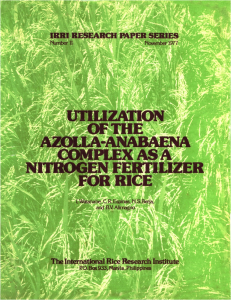 This classic book by Iwao Watanabe and his co-workers at the International Rice Research Institute in The Philippines documents the detailed methods for using azolla to biofertilize rice.
This classic book by Iwao Watanabe and his co-workers at the International Rice Research Institute in The Philippines documents the detailed methods for using azolla to biofertilize rice.
The Abstract (in part begins): “Because it contains the nitrogen fixing blue-green alga Anabaena azollae in its fronds, azolla grows on a nitrogen-free solution, doubles its mass in 3 to 5 days, and accumulates 30 or 40 kg of N/ha in 2 weeks.
A calcium or phosphorus deficiency in the azolla culture solution produces severe deterioration on growth. The optimum solution pH for azolla is 5.5; a higher pH produces iron deficiency. Azolla is sensitive to a temperature higher than 31 degrees C, which causes reddish-brown discoloration and reduces vigor…”
The book is available as a free download from the INFOSAT website.
‘Azolla as a Feed Ingredient: In Broiler Chicks Ration’ by Befikadu Zewdie
 Details (paraphrased from the Amazon website description):
Details (paraphrased from the Amazon website description):
“Broiler industry has become a rapidly developing enterprise within the sector of poultry production. But the industry is facing higher prices as well as non-availability of certain feed ingredients. The book discusses the main causes of the problem and provides solutions.
The book shows that the major causes hindering the growth of commercial poultry entry price in the study area are limited availability and the high price of conventional feedstuffs and agro-industrial by-products, resulting from the growing poultry industry which directly competes with cereal feed for human populations.
The study documented in the book demonstrates that replacing expensive commercial feed ingredients with locally-available azolla provides an alternative source of cheap protein which complements amino acid deficiencies in cereal-based broiler rations. This reduces the production cost for poultry, which has significant economic implications and improves the performance of carcass characteristics of broiler chicks.”
‘Azolla: A Biofertilizer and Waste disposer: Sustainable Agriculture and Environmental Protection.’ by Kunja Satapathy and Pradeep Chand
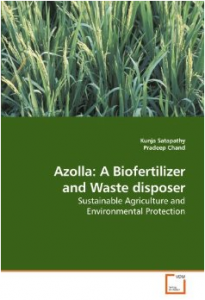 Details (paraphrased from the Amazon website description):
Details (paraphrased from the Amazon website description):
“In the context of fast depletion of soil fertility and high prices of chemical fertilizers, it has become imperative to use biofertilizers as a pollution-free low-cost input in agricultural production. Presently, the medium and low land rice fields around the urban and industrial areas are being polluted at an alarming pace not only due to domestic waste but also by industrial effluents.
This monograph is the first of its kind on highlighting the dual role of the water fern azolla in sustainable rice farming as well as decontaminating the polluted environment.
Endowed with a high nitrogen fixing cyanobacterial endosymbiont Anabaena azollae, the fern acts as an efficient biofertilizer especially for waterlogged rice fields; besides being a suitable waste disposer because of its ability of hyper-accumulating heavy metals from its aquatic environment.
This book is specially designed to motivate the marginal rice- growers of the developing countries in adopting azolla agrotechnology for sustainable agriculture as well as to develop a working strategy towards effectively protect agricultural fields from domestic and industrial pollutants.”
Isotopic Studies of Azolla and Nitrogen Fertilization of Rice: Report of an FAO/IAEA/SIDA Co-ordinated Research Programme on Isotopic Studies of … (Developments in Plant and Soil Sciences. Edited by K.S. Kumarasinghe and D.L. Eskew
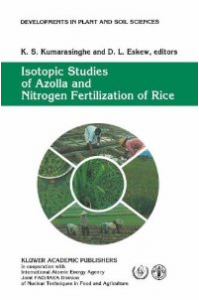 Details (from the Amazon website description):
Details (from the Amazon website description):
“Nitrogen is the most limiting element for crop production. Traditionally, expensive commercial fertilizers are used to correct soil nitrogen deficiencies. Indeed, 50% of the increase in rice yields after World War II can be attributed to increased fertilizer nitrogen use.
Although an increased rate of fertilizer nitrogen application has been advocated to meet the growing demand for food, it is unrealistic to advise the farmers to apply fertilizers they could hardly afford, and whose prices are likely to escalate in the years ahead. In addition, when they are not applied judiciously there are problems of environmental pollution as plants are capable of taking up only a relatively small portion of the applied nitrogen, a substantial amount being lost through various chemical and biological processes. The exploitation of cheaper alternatives or supplements to fertilizers have therefore gained much interest in recent years.
Our increased interest in biological nitrogen fixation as a supplement or alternative to nitrogen fertilizers led to the convening of a consultants’ meeting on `The Role of Isotopes in Studies on Nitrogen Fixation and Nitrogen Cycling by Blue-Green Algae and the Azolla-Anabaena azollae Association’, in Vienna from 11–15 October 1982.
The consultants’ group recommended that the Joint FAI/IAEA Division of Nuclear Techniques in Food and Agriculture embark on a coordinated research programme in this field and that initial emphasis should be placed on azolla-anabaena symbiosis. As a result, such a programme was initiated in 1984, which was concluded in 1989. The results and conclusions reported here are those that were generated during the five years of its operation.”
Usaha Tani Terpadu PATI (Padi, Azolla, Tiktok & Ikan) published by Agromedia Pustaka
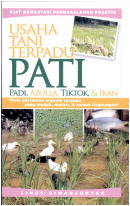 This book was recommended by Mahathir Abu Khalipah, one of our Foundation Associates who lives in Malaysia (mahathir_abukhalipah@yahoo.com). The description below is in Indonesian.
This book was recommended by Mahathir Abu Khalipah, one of our Foundation Associates who lives in Malaysia (mahathir_abukhalipah@yahoo.com). The description below is in Indonesian.
Description (www.kutukutubuku.com): “Buku ini membahas tentang usaha tani terpadu PATI yang merupakan singkatan dari padi, azolla, tiktok, dan ikan. Sebuah usaha tani organik yang ramah lingkungan serta efisien dalam pemanfaatan lahan. Konsep dasar dari PATI adalah mengusahakan padi, azzola, tiktok, dan ikan pada suatu lahan sawah irigasi secara bersamaan. Dengan cara pemelihaaan seperti ini, petani diharapkan akan memperoleh hasil yang berlipat.”
We currently have no details in English.
Penerapan Pertanian Organik
 This book was recommended by Mahathir Abu Khalipah, one of our Foundation Associates who lives in Malaysia (mahathir_abukhalipah@yahoo.com). The description below is in Indonesian.
This book was recommended by Mahathir Abu Khalipah, one of our Foundation Associates who lives in Malaysia (mahathir_abukhalipah@yahoo.com). The description below is in Indonesian.
Description (from the Kumpulan Bulletin): “Pengembangan Kawasan Rumah Pangan Lestari (KRPL) merupakan salah satu program Kementerian Pertanian yang harus didukung dengan berbagai inovasi, agar tujuan dan sasaran program tersebut dapat tercapai secara optimal.
Karena itulah maka Badan Litbang Pertanian melalui Balai Pengakajian Teknologi Pertanian (BPTP) berupaya menciptakan dan menerapkan inovasi yang telah di hasilkan dalam pengembangan Model Kawasan Rumah Pangan Lestari (M-KRPL) di Provinsi masing-masing.
Untuk Provinsi Sulawesi Selatan BPTP Sulawesi Selatan mengembangkan M-KRPL pada 15 Kabupaten, sebagai lokasi percontohan. Pada lokasi M-KRPL di 15 Kabupaten ini BPTP Sulawesi Selatan berupaya menerapkan prinsip-prinsip pertanian organik, sehingga menghasilkan sayuran dan buah organik yang dari segi kualitas dapat bersaing di pasaran.
Untuk mendukung hal tersebut, maka ketersediaan sarana yang di perlukan seperti pupuk organik dan pestisida organik di masing-masing lokasi M-KRPL, sesuatu yang mutlak.
Untuk itulah maka BPTP Sulawesi Selatan pada tgl 12 Juni 2012 melaksanakan kegiatan pelatihan pembuatan pupuk organik padat bertempat di lokasi M-KRPL Kab. Bulukumba yang berlokasi di kelompoktani binaan yaitu kelompok Wanitatani Bungungtammati di Desa Bukittinggi Kec. Gantarang Kab. Bulukumba. Bahan pembuatan pupuk organik yang digunakan adalah limbah pertanian dan sampah rumah tangga yang banyak tersedia di lokasi.
Hadir pada kesempatan tersebut para anggota Kelompok Wanitatani Bungungtammati sebanyak 30 orang, penyuluh pertanian setempat, Badan Ketahanan Pangan dan pelaksana penyuluhan pertanian Kab. Bulukumba serta peneliti dan penyuluh BPTP Sulawesi Selatan.
Pada kesempatan tersebut Kepala BPTP Sulawesi Selatan yang di wakili oleh Kasi KSPP mengharapkan kepada para peserta agar mengaplikasikan pengetahuan yang diperoleh dalam pelatihan ini di rumah masing-masing dan menularkannya kepada tetangga/anggota lain yang tidak sempat ikut dalam pelatihan ini.
Kepada pemerintah Kab. Bulukumba dalam hal ini Badan Ketahanan Pangan dan Pelaksana Penyuluhan Pertanian diharapkan dapat melanjutkan pembinaan kegiatan KRPL ini dan mereplikasikannya ke Desa-Desa lain, sehingga KRPL ini lebih memasyarakat.”
We currently have no details in English.

